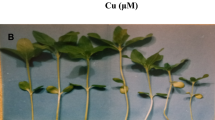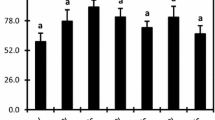Abstract
Although sunflower is usually regarded as a highly tolerant crop, impairment of root growth at initial stages of plant development may result in poor crop establishment and higher susceptibility to pathogen attack. In order to evaluate if Cd2+ and Cu2+ may impact on sunflower germination and initial root development, a pot experiment under controlled conditions was carried out. Possible involvement of polyamine metabolism in sunflower response to these stressors was also investigated. Although Cd2+ and Cu2+ treatments affect neither seed germination nor radicle emergence, sunflower seedlings grown in the presence of these heavy metals showed significant inhibition of root growth, being this inhibition greater for Cd2+. Both metals caused significant increases in proline contents at the highest concentrations tested (0.5 and 1 mM), and these increments were more pronounced for Cd2+ treatments, especially between days 3 and 10. Metals also increased putrescine (Put) contents at all concentrations assayed from the seventh day onward, causing no variations on this polyamine time-course pattern. Spermine and spermidine contents, however, were increased only by 1 mM Cd2+. Arginine decarboxylase seems to have been the enzyme responsible for Put increases under both metal treatments. This work demonstrates that initial root growth of sunflower seedlings may be significantly impaired in Cd2+ or Cu2+ contaminated soils. It also shows that polyamines are key biological compounds, which are probably involved in signaling pathways triggered under stress environmental conditions.




Similar content being viewed by others
References
Sanità di Toppi L, Gabbrielli R (1999) Response to cadmium in higher plants. Environ Exp Bot 41:105–130
Benavides MP, Gallego SM, Tomaro ML (2005) Cadmium toxicity in plants. Braz J Plant Physiol 17:21–34
Somashekaraiah BV, Padmaja K, Prasad ARK (1992) Phytotoxicity of cadmium ions on germinating seedlings of mung bean (Phaseolus vulgaris). Involvement of lipid peroxides in chlorophyll degradation. Physiol Plant 85:85–89
Stroinski A, Kozlowka M (1997) Cadmium-induced oxidative stress in potato tuber. Acta Soc Bot Pol 66:189–195
Boussama N, Ouariti O, Ghorbal MH (1999) Changes in growth and nitrogen assimilation in barley seedlings under cadmium stress. J Plant Nutr 22:731–752
Fornazier RF, Ferreira FF, Vitória AP, Molina SMG, Lea PJ, Azevedo RA (2002) Effects of cadmium on antioxidant enzyme activities in sugar cane. Biol Plant 45:91–97
Fernandes JC, Henriques FS (1991) Biochemical, physiological, and structural effects of excess copper in plants. Bot Rev 57:246–273
Halliwell B, Gutteridge JMC (1984) Oxygen toxicity, oxygen radicals, transition metals and disease. Biochem J 219:1–14
Luna CM, González CA, Trippi VS (1994) Oxidative damaged caused by an excess of copper in oat leaves. Plant Cell Physiol 35:11–15
Weckx JEJ, Clijsters HMM (1996) Oxidative damage and defense mechanisms in primary leaves of Phaseolus vulgaris as a result of toxic amounts of copper. Physiol Plant 96:506–512
Salt DE, Blaylock M, Kumar PBAN, Dushenkov V, Ensley BD, Chet I, Raskin I (1995) Phytoremediation: a novel strategy for the removal of toxic metals from the environment using plants. Biotechnology 13:468–474
Slocum RD, Kaur-Sawhney R, Galston AW (1984) The physiology and biochemistry of polyamines in plants. Arch Biochem Biophys 235:283–303
Evans PT, Malmberg RL (1989) Do polyamines have roles in plant development? Ann Rev Plant Physiol Plant Mol Biol 40:235–269
Tiburcio AF, Altabella T, Borrell T, Masgrau C (1997) Polyamines metabolism and its regulation. Physiol Plant 100:664–674
Bouchereau A, Aziz A, Larher F, Martin-Tanguy J (1999) Polyamines and environmental challenges: recent developments. Plant Sci 140:103–125
Mackintosh CA, Slater LA, Walters DR, Robins DJ (2001) Synthesis of six novel N,N-dialkyl derivatives of spermidine and effects on growth of the fungal plant pathogen Pyrenophora avenae. FEMS Microbiol Lett 202:221–225
Perez-Amador MA, Leon J, Green PJ, Carbonell J (2002) Induction of the arginine decarboxylase ADC2 gene provides evidence for the involvement of polyamines in the wound response in Arabidopsis. Plant Physiol 130:1454–1463
Groppa MD, Tomaro ML, Benavides MP (2001) Polyamines as protectors against cadmium or copper-induced oxidative damage in sunflower leaf discs. Plant Sci 161:481–488
Groppa MD, Benavides MP, Tomaro ML (2003) Polyamine metabolism in sunflower and wheat leaf discs under cadmium and copper stress. Plant Sci 164:293–299
Walters D (2003) Resistance to plant pathogens: possible roles for free polyamines and polyamine catabolism. New Phytol 159:109–115
Federico R, Angelini R (1991) Polyamine catabolism in plants. In: Slocum RD, Flores HE (eds) Biochemistry and physiology of polyamines in plants. CRC, Boca Raton, pp 41–56
Allan AC, Fluhr R (1997) Two distinct sources of elicited reactive oxygen species in tobacco epidermal cells. Plant Cell 9:1559–1572
Møller SG, McPherson MJ (1998) Developmental expression and biochemical analysis of the Arabidopsis atao1 gene encoding an H2O2-generating diamine oxidase. Plant J 13:781–791
Rea G, Laurenzi M, Tranquilli E, D’Ovidio R, Federico R, Angelini R (1998) Developmentally and wound regulated expression of the gene encoding a cell wall copper amino oxidase in chickpea seedlings. FEBS Lett 437:177–182
Rea G, Metoui O, Infantino A, Federico R, Angelini R (2002) Copper amine oxidase expression in defense responses to wounding and Ascochyta rabiei invasion. Plant Physiol 128:865–875
Cona A, Cenci F, Cervelli M, Federico R, Mariottini P, Moreno S, Angelini R (2003) Polyamine oxidase, a hydrogen peroxide-producing enzyme, is up-regulated by light and down-regulated by auxin in the outer tissues of the maize mesocotyl. Plant Physiol 131:803–813
Hoagland DR, Arnon DI (1950) The water culture method for growing plants without soil, Calif Agr Exp Stat Univ Calif Berkeley Circ 347
Smith BN, Meeuse BJD (1966) Production of volatiles amines in some Arum lily species. Plant Physiol 41:343–347
Flores HE, Galston AW (1984) Osmotic stress induced polyamine accumulation in cereal leaves. I. Physiological parameters of the response. Plant Physiol 75:102–109
Martin-Tanguy J (1997) Conjugated polyamines and reproductive development: biochemical, molecular and physiological approaches. Physiol Plant 100:675–688
Schat H, Sharma SS, Vooijs R (1997) Heavy metal-induced accumulation of free proline in a metal-tolerant and a nontolerant ecotype of Silene vulgaris. Physiol Plant 101:477–482
Bates LS, Waldren RP, Teare ID (1973) Rapid determination of free proline for water-stress studies. Plant Soil 39:205–207
Groppa MD, Ianuzzo MP, Tomaro ML, Benavides MP (2007) Polyamine metabolism in sunflower plants under long-term cadmium or copper stress. Amino Acids 32:265–275
Vitória AP, Lea PJ, Azevedo RA (2001) Antioxidant enzymes responses to cadmium in radish tissues. Phytochemistry 57:701–710
Wu FB, Chen F, Wei F, Zhang GP (2004) Effect of cadmium on free amino acid, glutathione and ascorbic acid concentrations in two barley genotypes (Hordeum vulgare L.) differing in cadmium tolerance. Chemosphere 57:447–454
Drazic G, Mihailovic N (2005) Modification of cadmium toxicity in soybean seedlings by salicylic acid. Plant Sci 168:511–517
Ranieri A, Castagna A, Scebba F, Careri M, Zagnoni I, Predieri G, Pagliari M, Sanità di Toppi L (2005) Oxidative stress and phytochelatin characterization in bread wheat exposed to cadmium excess. Plant Physiol Biochem 43:45–54
Van Assche F, Clijsters H (1990) A biological test system for the evaluation of the phytotoxicity of metal-contaminated soils. Environ Pollut 66:157–172
Wójcik M, Tukiendorf A (2003) Response of wild type of Arabidopsis thaliana to copper stress. Biol Plant 46:79–84
Landjeva S, Merakchijska-Nikolova M, Ganeva G (2003) Copper toxicity tolerance in Aegilops and Haynaldia Seedlings. Biol Plant 46:479–480
Xiong Z, Liu Ch, Geng B (2006) Phytotoxic effects of copper on nitrogen metabolism and plant growth in Brassica pekinensis Rupr. Ecotoxicol Environ Saf 64:273–280
Groppa MD, Benavides MP (2008) Polyamines and abiotic stress: recent advances. Amino Acids 34:35–45
Kuthanová A, Gemperlová L, Zelenková S, Eder J, Macháčková I, Opatrný Z, Cvikrová M (2004) Cytological changes and alterations in polyamine contents induced by cadmium in tobacco BY-2 cells. Plant Physiol Biochem 42:149–156
Choudhary A, Singh RP (2000) Cadmium-induced changes in diamine oxidase activity and polyamine levels in Vigna radiata Wilczek seedlings. J Plant Physiol 156:704–710
Cowley T, Walters DR (2005) Local and systemic changes in arginine decarboxylase activity, putrescine levels and putrescine catabolism in wounded oilseed rape. New Phytol 165:807–811
Panicot M, Masgrau C, Borrell A, Cordeiro A, Tiburcio AF, Altabella T (2002) Effects of putrescine accumulation in tobacco transgenic plants with different expression levels of oat arginine decarboxylase. Physiol Plant 114:281–287
Shih CY, Kao CH (1996) Growth inhibition in suspension-cultured rice cells under phosphate deprivation is mediated through putrescine accumulation. Plant Physiol 111:721–724
Lin CC, Kao CH (1999) Excess copper induces an accumulation of putrescine in rice leaves. Bot Bul Acad Sin 40:213–218
Maiale S, Sanchez DH, Guirado A, Vidal A, Ruiz OA (2004) Spermine accumulation under salt stress. J Plant Physiol 161:35–42
Thomas T, Thomas TJ (2001) Polyamine in cell growth and cell death: molecular mechanisms and therapeutic applications. Cell Mol Life Sci 58:244–258
Yoda H, Yamaguchi Y, Sano H (2003) Induction of hypersensitive cell death by hydrogen peroxide produced through polyamine degradation in tobacco plants. Plant Physiol 132:1973–1981
De Agazio M, Zacchini M (2001) Dimethylthiourea, a hydrogen peroxide trap, partially prevents stress effects and ascorbate peroxidase increase in spermidine-treated maize roots. Plant Cell Environ 24:237–244
Liao MT, Hedley MJ, Woolley DJ, Brooks RR, Nichols MA (2000) Copper uptake and translocation in chicory (Cichorium intybus L. cv Grasslands Puna) and tomato (Lycopersicon esculentum Mill. cv Rondy) plants grown in NFT system. II. The role of nicotianamine and histidine in xylem sap copper transport. Plant Soil 223:243–252
Mazen AMA (2004) Accumulation of four metals in tissues of Corchorus olitorius and possible mechanisms of their tolerance. Biol Plant 48:267–272
Acknowledgements
This work was supported by the University of Buenos Aires (Grants B001 and B044). Groppa MD, Benavides MP, and Tomaro ML are researchers of the Consejo Nacional de Investigaciones Científicas y Técnicas (CONICET).
Author information
Authors and Affiliations
Corresponding author
Rights and permissions
About this article
Cite this article
Groppa, M.D., Zawoznik, M.S., Tomaro, M.L. et al. Inhibition of Root Growth and Polyamine Metabolism in Sunflower (Helianthus annuus) Seedlings Under Cadmium and Copper Stress. Biol Trace Elem Res 126, 246–256 (2008). https://doi.org/10.1007/s12011-008-8191-y
Received:
Accepted:
Published:
Issue Date:
DOI: https://doi.org/10.1007/s12011-008-8191-y




